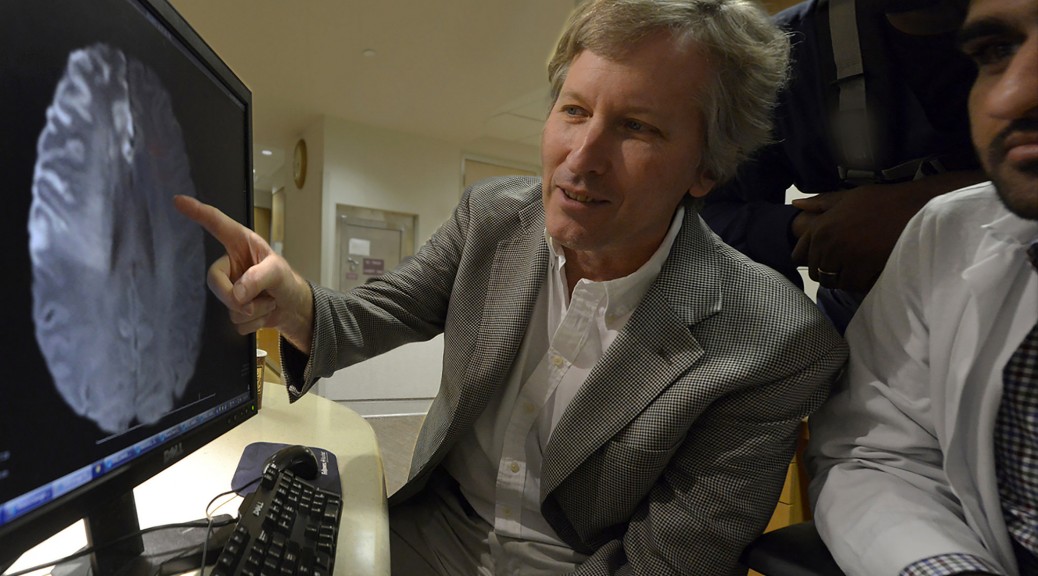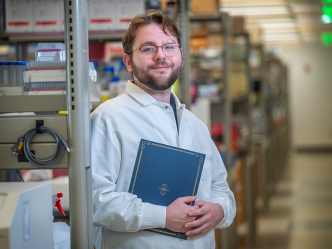A new study is looking at whether short, daily bouts of reduced blood flow to an arm or leg can reduce the ravages of dementia.
It’s called remote conditioning, and researchers say it activates natural protective mechanisms in the brain that should help about half of dementia patients.
The approach uses a blood pressure cuff-like device to temporarily restrict blood flow to an appendage repeatedly for a few minutes each day, which increases blood flow to other body areas, including the brain, said Dr. David Hess, Chairman of the Department of Neurology at the Medical College of Georgia at Georgia Regents University.
Increased flow activates endothelial cells lining blood vessels, calling to action a series of natural protective mechanisms that can be effective wherever blood travels, Hess said. Interestingly, the mechanisms seem most active in areas of impaired flow, such as those deep inside the brain, where most dementia has its roots.
“The most powerful way to protect the brain is to cut off blood flow to it for a short period of time to condition it,” said Hess. “What it does is elicit these protective pathways so when potentially lethal ischemia comes, you can survive it.” What it also appears to do is help permanently improve blood flow to these deep regions of the brain.
Age and being a female are two of the major risk factors for dementia. With nearly 15 percent of the U.S. population age 65 and older and half being female, Hess calls dementia a major health concern. “This is a big epidemic coming. This is a big killer and disabler, and everybody is concerned about this.”
A two-year, $750,000 translational grant from the National Institute of Neurological Disorders and Stroke should help Hess and his research team do the additional animal studies needed to move this safe and inexpensive technique for dementia to human studies.
“We think reduced cerebral blood flow, particularly in the deep white matter, is a major trigger of dementia,” Hess said. The white matter is primarily composed of axons, which connect neurons and different areas of the brain to each other and enable the brain to communicate with the body. The white protective coating on the axon is why this deep brain area is called white matter.
Hess, who is also a stroke specialist, says this area is particularly vulnerable to ischemia because the blood vessels that feed it are small and have long, tortuous routes. Strokes and/or impaired blood flow can lead to classic dementia symptoms such as forgetfulness and an unsteady gait.
By age 70, essentially everyone has some white matter disease, but in some it can be devastating. “You cannot go out in a car and find where you are going. You may not even be able to find your car. You can’t cook meals without setting the house on fire,” Hess said.
“What we want to do long term is find people who are at risk for dementia – they already have some white matter damage you can see on an MRI – then we condition them chronically with this device in their home,” Hess said. Chronically is a key word because, as with exercise, when this conditioning stops, so do its benefits. In fact, this passive therapy provides blood vessels many of the same benefits as exercise. “If you can exercise, you probably don’t need this,” Hess adds.
Previous studies in their animal model of vascular dementia have shown that just two weeks of daily, short bouts of ischemia to an appendage can improve the health of the important white matter. The new grant is allowing them to use a similar approach for periods of one and four months in older mice of both genders to better understand the mechanisms of action and how long and how often therapy is needed. While they don’t make as much as human, mice do make more amyloid, a protein that deposits in the brains of patients with Alzheimer’s, when brain blood flow is impaired. Mice make less with the conditioning, so the researchers also are looking further at that result.
A small intramural grant is enabling similar studies with a pig model in collaboration with University of Georgia colleagues Dr. Simon R. Platt, professor of neurology and neurosurgery in the College of Veterinary Medicine, and Dr. Franklin D. West, assistant professor in the College of Agricultural and Environmental Sciences.
While he notes that multiple natural mechanisms are activated, Hess and his team are focusing on how the temporary bouts of increased blood flow prompt endothelial cells to make the precursor for the blood vessel dilator nitric oxide.
“The enzyme that makes nitric oxide is upregulated and stimulated quickly,” Hess said. Nitric oxide gas has a short life, but when a lot is dumped in the blood, it’s oxidized into nitrite – the same stuff put in hot dogs – which circulates throughout the bloodstream so it goes wherever blood goes. Although just how this happens is unclear, when the nitrite gets to an area of low blood flow, it is converted back to nitric oxide, which helps improve flow, Hess said.
The MCG researchers are applying for federal funding to do trials in humans who are at high risk for stroke because of small vessel disease deep in the brain. In 2012, they published results of a small study in the journal Stroke indicating that successive, vigorous bouts of leg compressions following a stroke trigger natural protective mechanisms that reduce damage and double the effectiveness of the clot buster tPA. Similar studies have been done by others in patients with heart disease.
Vascular dementia is considered the second most common cause of dementia after Alzheimer’s disease, according to the Alzheimer’s Association. There are currently no drugs approved by the U.S. Food and Drug Administration specifically for vascular dementia.
Collaborators at MCG and GRU include Dr. Mohammad B. Khan, postdoctoral fellow in Dr. Hess’ lab; Dr. Nasrul Hoda, College of Allied Health Sciences; Dr. Philip Wang, Department of Psychiatry and Health Behavior; Dr. Ali Syed Arbab, Department of Biochemistry and Molecular Biology; Dr. Nathan Eugene Yanasak, Department of Radiology and Imaging; and Dr. Jennifer Waller, Department of Biostatistics and Epidemiology.
 Augusta University
Augusta University




